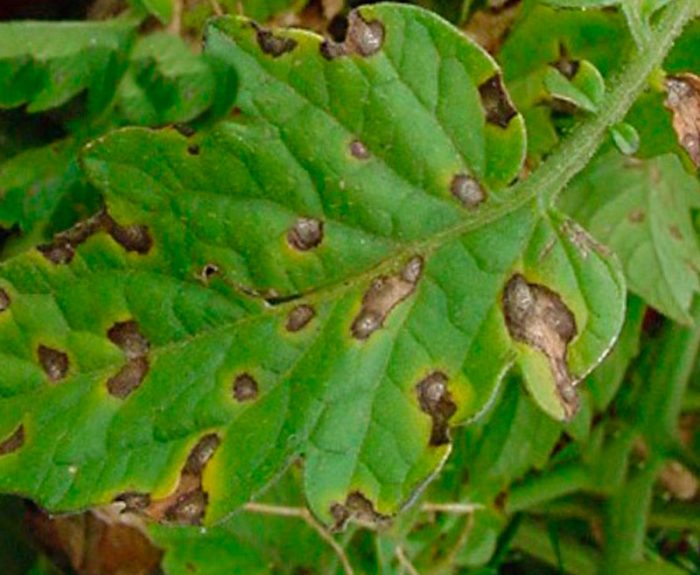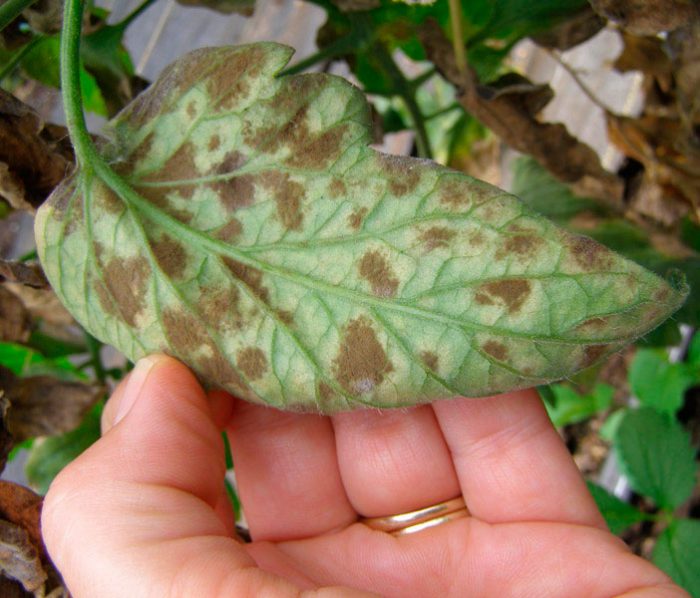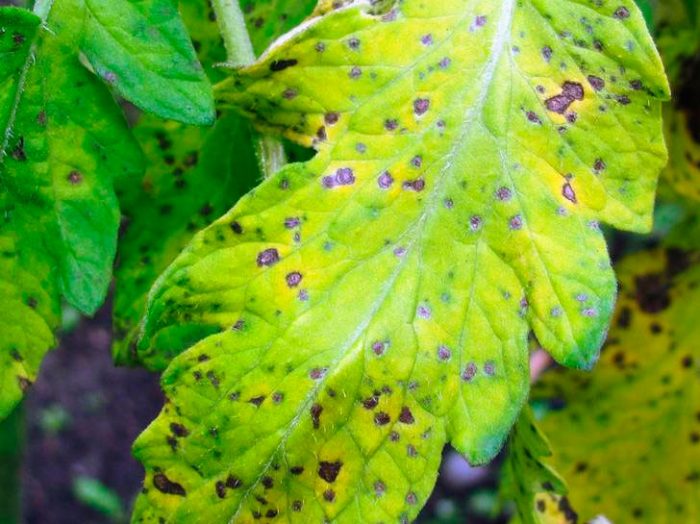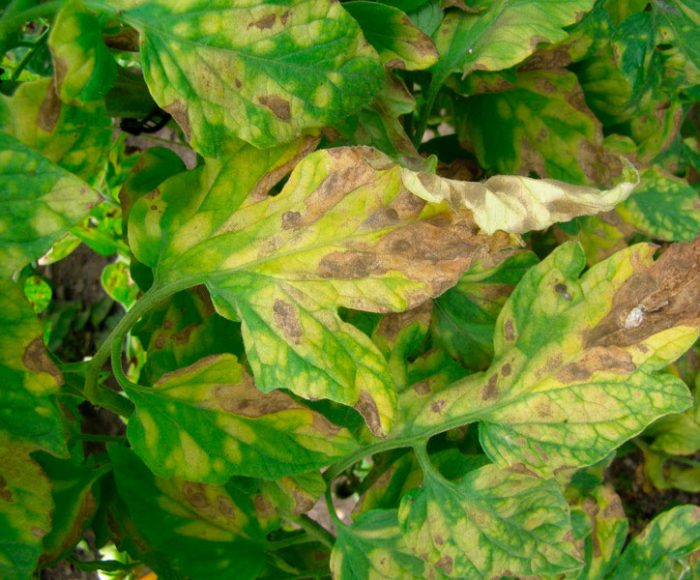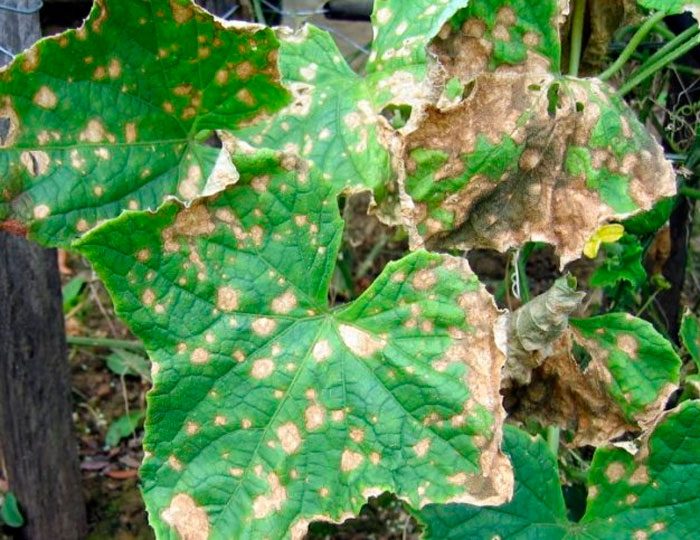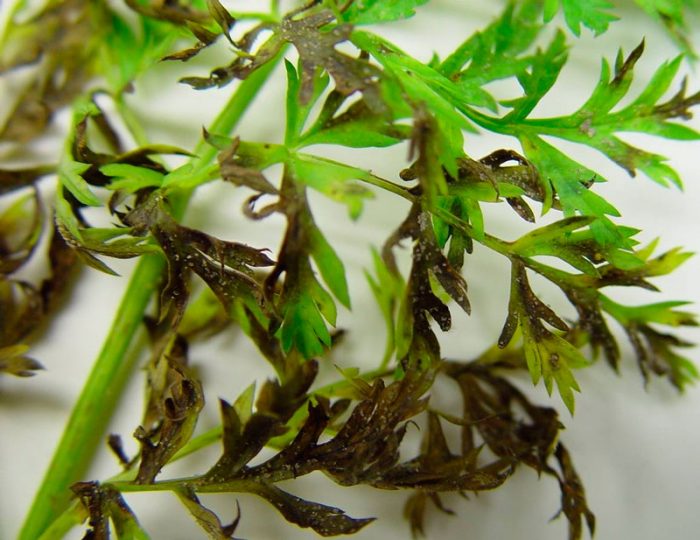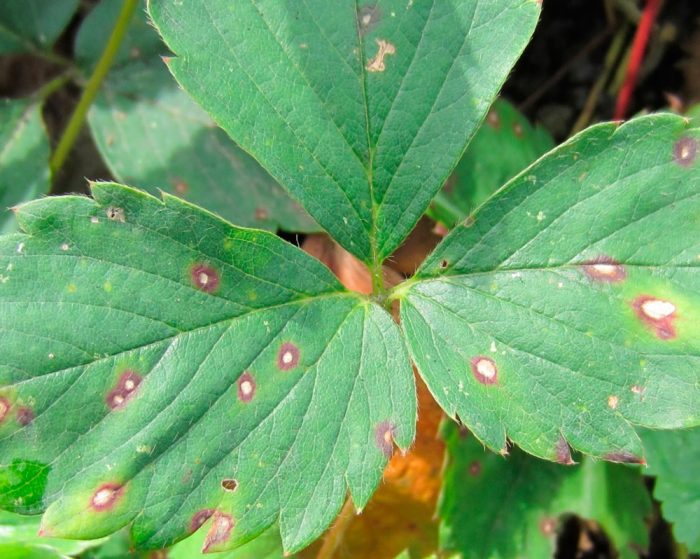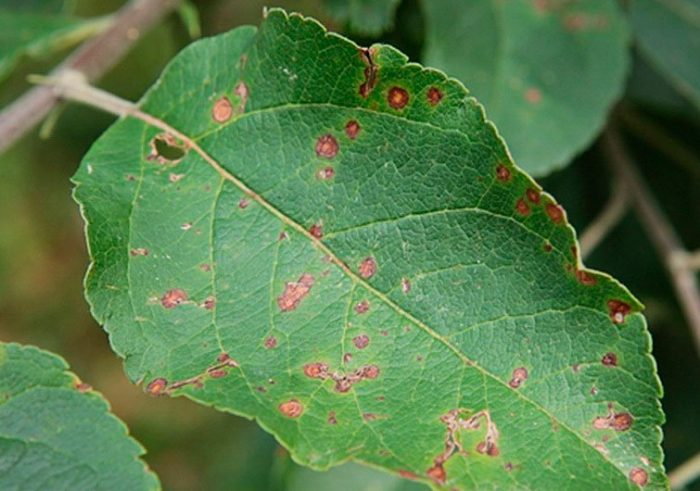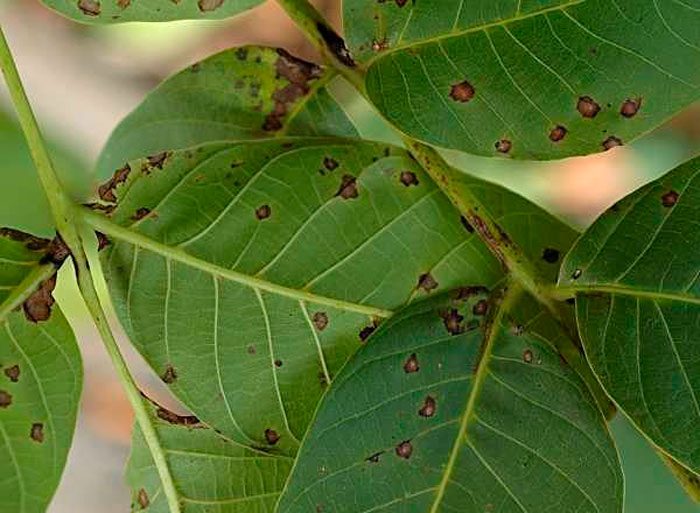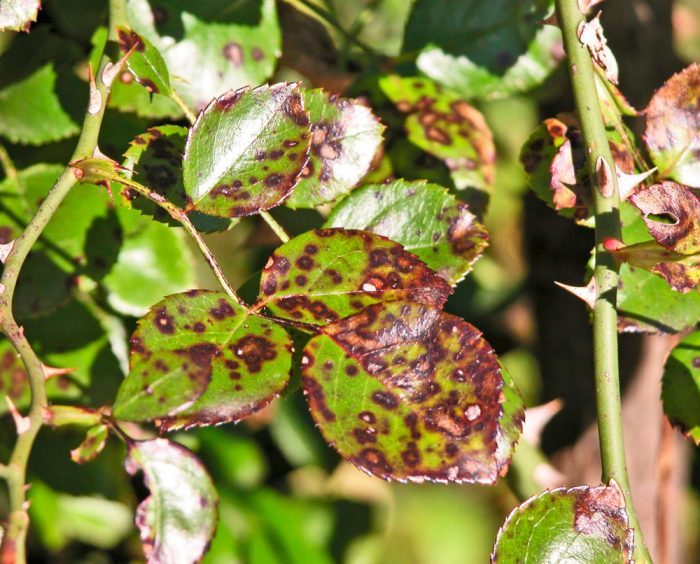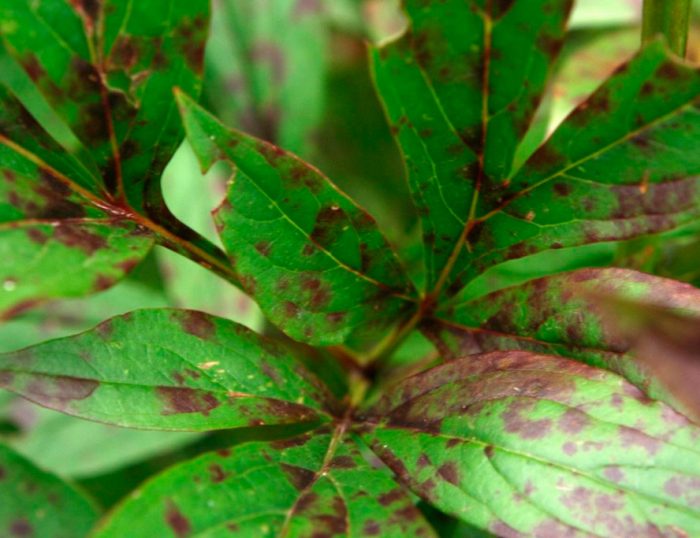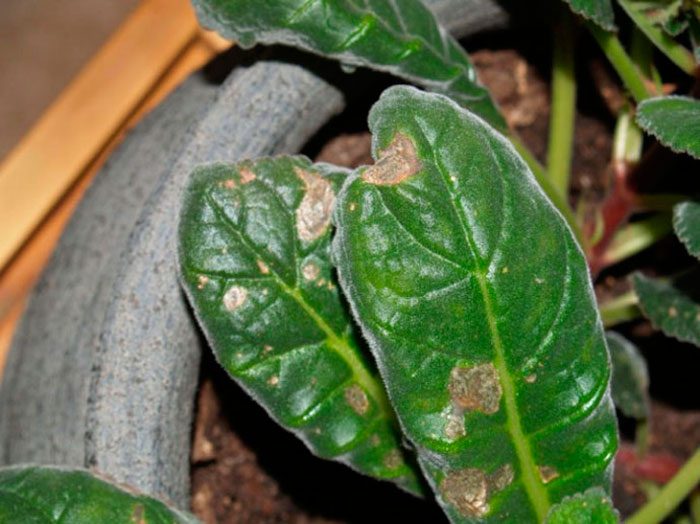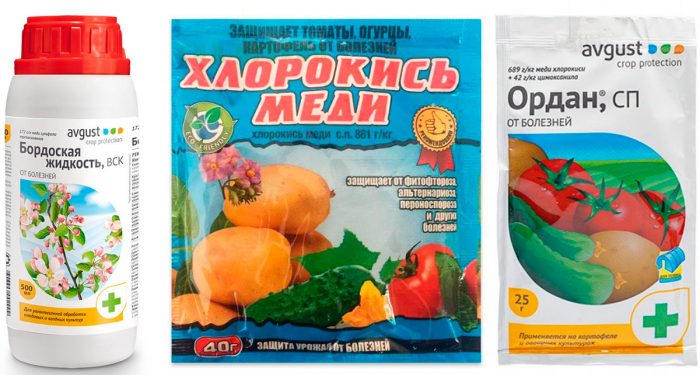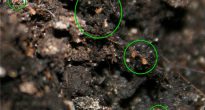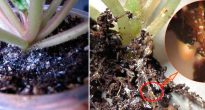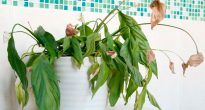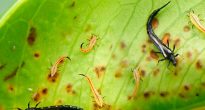A fungal disease, brown spot or leaf mold, is a danger to many plants. Although this disease is less dangerous than late blight, due to brown spot, under certain conditions, up to half of the crop can die. An interesting fact is that late blight cannot settle on bushes affected by brown spot, because these fungi could not exist next to each other.
Content
Features of brown spot
The first symptoms of the disease can be found during the flowering period, for example, pale olive specks appear on the front surface of the lower leaf plates, eventually changing their color to yellow, and a brownish-green or grayish bloom forms on the seamy side. This plaque contains spores of the fungus, and if you touch it, they will scatter in different directions and settle on the bushes and foliage located in the neighborhood. The foliage infected with the disease begins to dry out. The shoots and fruits of the plant are not affected by this fungal disease, however, they develop and grow much worse due to lack of nutrition, because the affected foliage cannot support photosynthesis.
This disease begins to develop intensively with high humidity and can affect crops growing both in the open field and in the greenhouse. Various plants are affected by leaf mold, but cucumbers, strawberries, tomatoes, roses, and even indoor plants and fruit trees are most susceptible to it.
It is necessary to start actively fighting brown spotting immediately after the first symptoms of the disease are detected. And the fight against the disease is complicated by the fact that in different cultures it is caused by different pathogens. For example, the fungus Cladosporium fulvum attacks tomatoes, while on cucumbers the olive spot begins to develop due to the fungus Cladosporium cucumenium. That is why the brown spot of cucumbers and tomatoes is also called "cladosporiosis". Roses get sick with leaf mold as a result of infection by the fungus Monochaetia depazeoides, and strawberries are affected by the fungus Marssonina pettontillae and then symptoms of this disease develop. Another brown spot is the phyllosticosis of pears, apple trees, host and houseplants.Although the pathogens are different, the signs of a developing disease are very similar, and all these pathogens are fungi. In this regard, experts have combined all these diseases into one called brown spot.
Brown spot treatment
Since brown leaf spot is a fungal disease, antifungal drugs are used to combat it, or rather, copper-containing fungicides. These funds can be purchased in a specialized store, or you can make them yourself, because there are many effective folk remedies that have been used by gardeners and gardeners for more than one hundred years.
If decorative shrubs or flowers are affected by leaf mold, then they can be safely treated with pesticides. However, it is recommended to spray fruit, berry and vegetable crops with chemicals only as a last resort, since the toxins they contain can accumulate in the fruit. Crops, the fruits of which are used for food, cease to be treated with fungicides immediately after the start of fruit growth or no later than 30 before harvesting. Several sprays will be required to heal the affected plant, and the initiation of treatment depends on the situation.
Prevention
If you do not forget about preventive measures, then your plants may never get sick with brown spot. Basic preventive measures:
- It is recommended to grow varieties that are resistant to leaf mildew.
- All seeds must undergo pre-sowing treatment, for this they are poured into a thermos filled with warm (45-50 degrees) water for 30 minutes.
Also, one should not forget that if the plant is strong and well-groomed, then almost all diseases and pests are not afraid of it. That is why you need to properly care for it, and also do not forget about the agrotechnical rules of culture.
All plants need good air exchange. That is why all leaf plates that are below the fruits are removed from tomatoes, the crowns of shrubs and trees are regularly thinned out, and the greenhouses are systematically ventilated. Watering is recommended in the early morning, and warm water is used for this. Try to keep water droplets away from the surface of the sheet plates. Also, make sure that the soil between watering does not completely dry out, as this leads to weakening of the plants. Also, in order to prevent the development of brown spotting, it is recommended to feed crops with phosphorus-potassium fertilizers, and fresh bird droppings and manure should not be added to the soil, because this contributes to the development of fungal flora. When the season comes to an end, the site must be cleaned of plant residues, and greenhouses are disinfected, for example, they burn sulfur briquettes or use tar soap.
It is also recommended to carry out preventive treatments with a solution of a fungicidal preparation. The first time the culture is sprayed in early spring before it blooms, and after 15 days, it is re-treated.
Brown spot on plants
Brown spot on tomatoes
In tomato bushes affected by brown spotting, yellow specks form on the front surface of the leaf plates, and a brownish-gray bloom (sometimes with a purple tint) on the back. If the bush is very badly affected, then plaque appears on the upper side of the foliage. As the disease progresses, the foliage turns brown, wilting is observed, but it does not fly around. Very rarely flowers and fruits are also affected by this disease. The affected bush does not have enough strength for normal growth and development, therefore it gives a poor harvest.
The disease develops most actively in warmth (from 20 to 25 degrees) and at high air humidity (at least 90%).If the temperature is increased to 25-30 degrees (it is quite possible to do this in a greenhouse), and the level of air humidity is lowered to 60 percent, this will lead to a suspension of the development of brown spot. However, those leaf plates that are already affected by the disease will have to be cut off and burned, because they will no longer be cured. The affected foliage is cut very carefully, trying to prevent the spores of the fungus from spraying. Also, rake up all the foliage that has flown around and destroy it, as it may also contain fungal spores.
The fight against the disease should be started immediately after the first symptoms of leaf mold are detected. To do this, the affected tomato bushes are treated with a Barrier solution (8 grams per bucket of water). Moisten all the foliage well with it, and the solution should fall on both the upper and lower surfaces. Also, the following preparations can be used for processing tomatoes: Polychom, copper oxychloride, Captan, Tsineb and other fungicides. Such pesticides can be freely purchased at any specialized store, but do not forget that you need to use them strictly following the instructions on the package. Re-spraying is carried out after 1-1.5 weeks, but when 30 days remain before harvesting, all treatments with pesticides are stopped. In the event that tomatoes are still sick, folk remedies are used to treat them, which are less dangerous than pesticides.
When the crop is harvested, remove all plant residues from the site and dig it up. For prevention purposes, experts advise choosing varieties that are resistant to brown spotting for cultivation, for example: Vezha, Red Comet, Our Masha or Centaur.
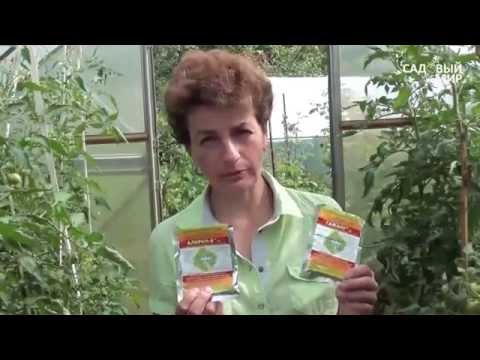

Watch this video on YouTube
On cucumbers
Most often, the first symptoms of brown spot on cucumbers begin to appear in mid-summer. This disease affects both the stems and foliage, and the fruits, on the surface of which ulcers appear with a bloom, and they can no longer be eaten. Most often, the development of cladosporiosis occurs in a greenhouse, and pathogenic fungi can persist in plant debris and soil for two or three years. In the event that you are too lazy to disinfect the greenhouse before planting cucumbers, the likelihood increases that the bushes will be affected by brown spot immediately after conditions favorable for its development are established, namely: drafts, high air humidity, frequent temperature drops, as well as sprinkler irrigation.
If you find the first symptoms of the disease on the bushes, stop watering for several days, systematically ventilate the greenhouse, and also cut off all parts of the bushes that are affected by spotting. In the event that the cucumbers grown in the garden are affected by the disease, then together with the infected foliage from the bushes, it will be necessary to cut off all the extra leaf plates. If the brown spot began to develop due to a prolonged cold snap, then it is recommended to cover the bushes for a while.
To cure diseased cucumbers, it is recommended to use the same fungicides containing copper as for tomatoes. To make the treatment solution "stick" to the surface of the plant better, you can add a little dishwashing detergent or liquid soap to it. To completely get rid of the disease, you will need to spend 2 sprays with a fungicide with a break of 1-1.5 weeks.
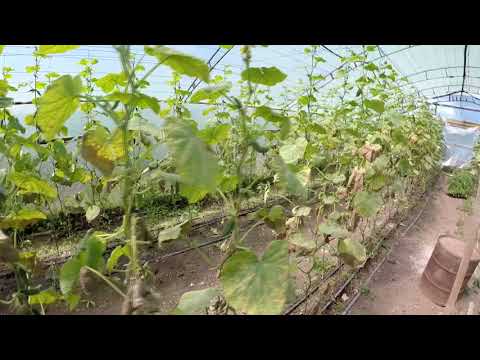

Watch this video on YouTube
On carrots
Carrots are also susceptible to brown spotting. Its causative agents in this case are Alternaria dauchi, therefore, the disease is also called Alternaria. If the carrot is affected by such a disease, then its yield may decrease by 35-50 percent.
The first signs of the disease can be found already on the seedlings, for example, dark brown constrictions appear on the shoots at the level of the soil surface. If the plants are young, then they die almost immediately. In the event that adult bushes were already affected by brown spotting, then at the beginning specks of brown color with a dark border form on the petioles, foliage and shoots, then the foliage begins to curl and looks as if boiling water was poured onto it. Sometimes the disease also affects the root crop, on which small brownish specks of rot appear, which penetrate very deeply into the fruit.
To cure a carrot affected by Alternaria, it is necessary to use special chemicals, and also not to forget about preventive measures, namely:
- for growing, choose hybrids and varieties that are resistant to disease;
- be sure to carry out pre-sowing preparation of seed material, while using the thermal method;
- apply a large amount of phosphorus and potassium to the soil in the garden, especially if the soil in the area is loamy;
- do not forget about the rules of crop rotation;
- after harvesting, clean the surface of the site from plant residues, and also dig up the soil.
After the first symptoms of the disease are found on the carrot, it should be sprayed with a solution of Bravo or Quadris, repeated processing is carried out after 1-1.5 weeks.
Brown spot of strawberry (strawberry)
Brown spot, which affects almost all varieties of strawberries, is also called "marsoniasis". In affected bushes, their development noticeably worsens, and after a while they die. The first symptom of the disease includes specks of purple or brown color that form on old leaf plates, over time they increase in size. As a result, foliage dries up and dies, and on cloudy days, rainwater washes away pathogenic spores from its surface, which, together with water, enter the soil and infect new bushes.
As soon as the diseased leaf plates are found, they are cut off, while being extremely careful not to shake off the spores of the fungus from them. If the bush is very badly affected, then it is recommended to destroy it entirely, and if possible, you can leave two young leaves, which are necessarily sprayed with a solution of a fungicidal preparation. To cure strawberries from brown spot, you will need to treat the area twice with the fungicide Euparen, namely, before flowering and after the harvest has been harvested. It should be noted that this product is very poorly soluble in water, in this regard, it must be mixed well and left for some time. Then stir the mixture thoroughly again and carefully drain the solution so that any particles that have not dissolved remain in the bucket.
The drug Gamair is also quite effective in combating this disease. For preventive purposes, in the autumn, after harvesting, strawberries can be sprayed with a solution of Falcon, Bravo, Ridomil, Bordeaux mixture, copper oxychloride, Ordan, Rovral, Horus, Metaxil or copper sulfate, and you must strictly follow the instructions (see the package).
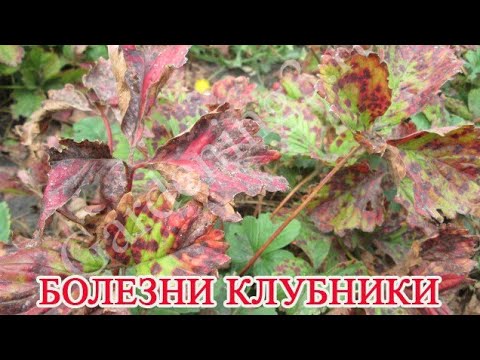

Watch this video on YouTube
Brown spot of apple and pear
The foliage of quince, raspberry, pear and apple trees can also be affected by brown spotting (in this case, it is also called phyllosticosis). The spots appearing in this case on the leaf plates are outwardly similar to scab spots, but there is no velvety plaque on their surface.
In a diseased plant, you need to cut off all affected leaf plates, and also remove all fallen leaves. All these leaves must be destroyed, since they contain pathogenic fungi. The plant itself is sprayed twice with a 1% solution of copper sulfate or Bordeaux mixture: before flowering and immediately after it has faded.In the event that the plant has already been treated for scab, then this will be enough to combat phylosticosis.
The symptoms of phyllosticosis are very similar to those of another fungal disease of fruit trees, which is called coccomycosis. In this case, spots are also formed on the foliage, reaching no more than 0.2 cm in diameter, which are painted in a pale red or brown color, but at the same time a light pink or white bloom appears on the seamy surface of the plate. And cherries and cherries are most susceptible to coccomycosis, and not pears with apple trees, but most gardeners prefer to play it safe, and therefore, after flowering, they spray the plants with chemical agents for scab.
Brown spot on a walnut
Brown spot on walnuts, also called marsoniasis, affects both stems and foliage. The disease is activated with a strong increase in the level of air humidity, which is observed during prolonged rains. It poses the greatest danger during flowering, since at this time the disease can destroy almost all flowers. The mottling can also affect the fruits of this plant.
To cure a walnut from marsoniasis, it must be treated with a solution of Bordeaux mixture (3%) in early spring, before sap flow begins. Repeated treatment, but already with a 1% solution, is carried out during the growth of foliage, and after half a month the plant is sprayed a third time.


Watch this video on YouTube
Brown spot on flowers
Brown spot on roses
Brown spot can also affect roses, in this case the disease is called marsoniasis and cercospora. Varieties with glossy foliage are affected by this disease much less often than others. To cure the affected rose, it must be treated twice or three times with a break of 4-5 days, for this, use means containing copper, for example: Tsineb, Bordeaux mixture (1%), copper oxychloride (0.4%), Benlate or solution copper sulfate (2-3%), and in order for it to better adhere to foliage, add 200 to 300 grams of liquid soap to it. Before proceeding with the treatment, remove from the bushes all affected, as well as flying leaf plates, which must be destroyed. In late autumn, before preparing the bushes for wintering, they should be sprayed with Bordeaux mixture or copper sulfate. To avoid the spread of the disease to other plants, the surface of the soil under the bushes is covered with a layer of mulch, which is used as mowed chopped grass.
Peonies
The defeat of peonies with brown spotting (cladosporium) occurs in the first half of the summer period. Disease affects shoots and foliage, and buds and flowers get sick much less often. In order to cure peonies, they can be treated with one of the following agents: copper sulfate with liquid soap, Tsineb, Benlat, Bordeaux liquid, Fundazol, Bravo, or other fungicidal preparations. The first time the plant is sprayed when it fades, then the treatment is repeated, if necessary, with an interval of 10-12 days. However, before spraying the bush with the drug, all affected leaf plates and shoots are cut off from it.
Lilac
Lilacs are also affected by brown spotting (phyllosticosis). The first signs of damage are brownish-gray, dark-bordered specks that form at the base of the leaves. The spots increase in size over time, connect to each other, and the tissue in them dries up and spills out. As a result, holes appear on the affected leaf plates. As a rule, the development of the disease occurs in the middle of the summer period.
All affected, as well as fallen leaves must be removed and destroyed.The processing of the bushes is carried out twice a year, namely, in early spring and at the end of leaf fall in the fall, and a solution of Bordeaux mixture (2%) is used for this. In the summer, if desired, lilacs can be treated 2 or 3 times with a 1% solution of any product containing copper.
Brown spot on indoor plants
Most houseplants are also affected by brown spotting (phyllosticosis). In this case, the disease begins to actively spread and develop due to the very frequent humidification of plants from a spray bottle. This disease can affect ficus, palm, clivia, ivy and other plants.
In order to prevent brown spots, provide the flowers with fresh air and the optimal amount of light. Do not place them so that they are cramped. Watering indoor plants is recommended sparingly. Any soil mixture used both for planting and for transplanting flowers must be disinfected, and the tools that are used to care for plants must also be sterile. To do this, the substrate can be spilled with a pinkish solution of manganese potassium, and the inventory is washed with alcohol or boiled. As soon as leaf plates with suspicious specks appear on the bushes, they are immediately plucked and destroyed.
If the plant is still struck by brown spot, then the following drugs are used to cure it: Bordeaux liquid, Fitosporin-M, copper sulfate, the biological product Gamair or the Vectra systemic fungicide. The bush will need to be processed twice or three times with a break of 1-1.5 weeks.
Remedies for brown spot (preparations)
In the fight against brown spot, fungicidal preparations are used, which, according to the nature of their distribution, are divided into systemic and contact ones, and according to their action - into immunizing, therapeutic and protective (prophylactic) preparations. According to the purpose of use, all preparations are divided into those that are used for disinfecting the ground in greenhouses and greenhouses, for etching seed during pre-sowing preparation, for spraying the plant during the growing season and for processing perennials, which will protect them throughout the rest period.
In the fight against brown spot, the following fungicidal agents are used:
- Bordeaux liquid... This blue suspension is of little danger to humans. It is used to combat various fungal diseases, including cercosporosis, alternaria and coccomycosis, for this, a solution of the agent with a concentration of 1% is used. However, at the beginning of spring, when the buds are not yet swollen, a “blue spraying” is carried out with a solution of Bordeaux mixture (2-3%).
- You can replace Bordeaux mixture copper-soap emulsion... To prepare it, dissolve from 150 to 200 grams of soap in 9 liters of rainwater. 1 liter of water is poured into a separate dish made of plastic, in which 10 to 20 grams of copper sulfate is dissolved, then carefully pour this solution into soapy water. The final color of the solution should be pale green and free of flakes.
- Copper oxychloride (oxychloride)... The drug is available in powder and tablet form. It is used in the form of a suspension, while its properties are similar to the Bordeaux mixture.
- Ordan... Contact-systemic agent, which includes cymoxanil and copper oxychloride. It is used in the fight against various fungal diseases, including spotting.
- Ridomil... Systemic contact agent that is used in the fight against fungal diseases.
- Falcon... This systemic three-component drug has a protective, therapeutic and eradication effect against various fungal diseases.
- Euparen... Preventive contact agent. It destroys phytopathogenic fungi.
- Gamair... This biological bactericidal agent is similar in composition to Fitosporin. It is distinguished by a powerful healing and protective effect, and at the same time it is completely harmless to humans.
- Fitosporin-M... This biological contact agent is used to protect tubers, seeds, bulbs and soil.
- Tsineb... Systemic pesticide with contact action.
- Bravo... This broad-spectrum contact agent is used to protect against fungal diseases.
- Horus... A systemic agent used in the fight against scab and other fungal diseases.
- Rovral... This contact preparation is quite effective in treating plants affected by fungal diseases.
- Fundazol or Benlat... This broad-spectrum systemic agent is used as a disinfectant, it differs in both prophylactic and therapeutic effects.
Folk remedies
There are also folk remedies that are used in the fight against brown spot. The most effective ones are as follows:
- Combine 1 liter of whey with 10 liters of water. Spray the composition of the plant.
- Half a bucket of water is combined with 500 ml of skim milk and 15 drops of iodine. Bushes are also treated with the mixture.
- Once a week, a pinkish solution of potassium permanganate and a decoction of coal ash are used alternately to water the plant (boil 0.3 kg of ash in a bucket of water for 30 minutes).
- Pour 0.5 kg of finely chopped garlic arrows and cloves into a bucket of water. The infusion will be ready in 24 hours, it is drained and used to process plants.
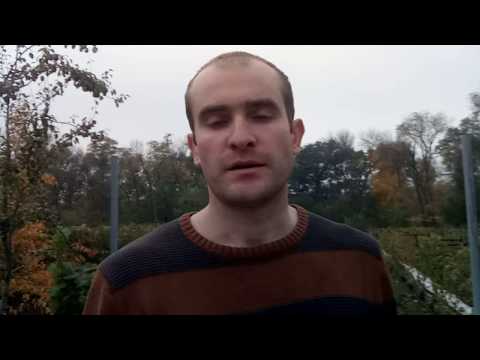

Watch this video on YouTube

